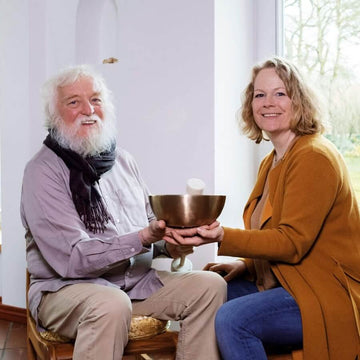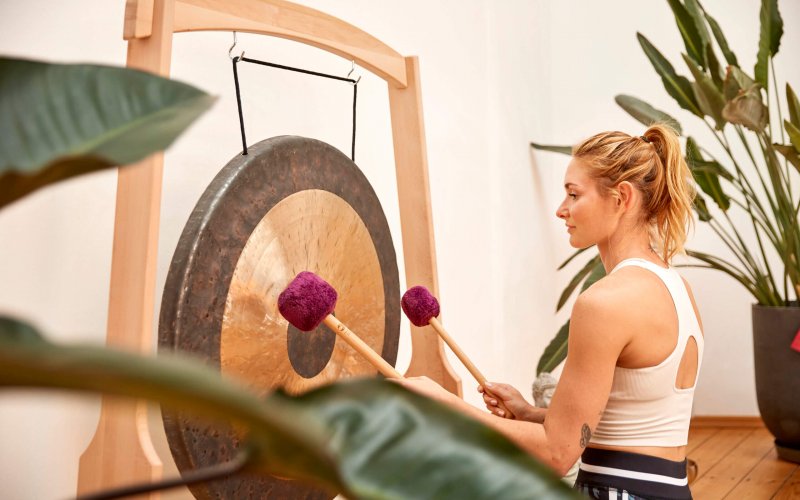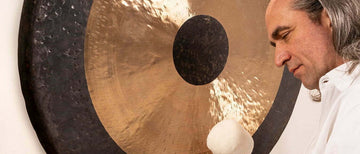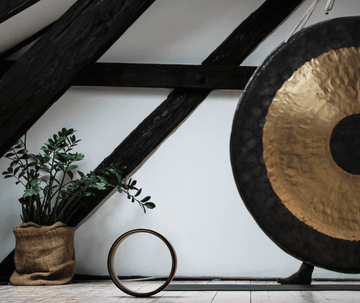
Key points at a glance
- Gongs are generally divided into two categories: Flat Gongs and Bossed Gongs.
- The TamTam Gong and the Feng Gong are among the most popular Flat Gongs.
- Gongs vary in shape, size, and the materials they are made from.
- The quality and craftsmanship of the gong significantly determine its sound.
- The gong is very versatile and can be a valuable addition to various applications.
What is a gong and where does it come from?
The gong is an instrument that originated in Asia. It was used in rituals, ceremonies and by monks. Today, the gong can be found throughout Europe. The instrument is not only used in classical music or in the orchestra – the sound of the gong also blends harmoniously into modern songs. It is used particularly frequently in sound work. There it provides relaxation and can bring relief from many ailments.
To help you determine if a gong is the right instrument for you and your needs, we've compiled some common applications.
Applications of the gong:
- Used in Peter Hess® Sound Massage and Peter Hess® Sound Methods
- Sound exercises for self-application
- Sound and imagery journeys
- Concerts
- Support for meditation and yoga
A gong is made of a round metal disc that can be completely flat or slightly curved. The disc is hammered, rolled, and refined in an elaborate process. Only when all process steps have been completed can the unique sounds of the gong be produced. The process is complex and demonstrates how much dedication and attention to detail goes into this often underestimated instrument.
Once the metal disc is finished, it's attached to a gong stand with a mount, allowing it to swing freely and produce the best possible sound.
How to find the right gong for you
- Decide what you mainly want to use the gong for.
- Listen to different gong sound samples online to find out which tones and frequencies you like.
- Pay attention to quality and check in particular the materials used and the manufacturing process – both have a significant impact on the sound.
- Decide on a budget you're willing to invest in your new instrument.
- If you're unsure, talk to an expert and get advice on the different types of gongs.
What types of gongs are there?
Gongs come in many different sizes. Their shape and the use of different materials allow them to produce a very broad range of sounds. Depending on their characteristics and origin, they are divided into different categories or subcategories.
Basically, there are two categories: Flat Gongs and Bossed Gongs.
These two types of gongs are among the most well-known instruments. As the name suggests, the flat gong has a relatively flat disc, whereas the bossed gong is clearly curved in the middle.
Good to know
A distinction is usually made between two categories: the Flat Gong and the Bossed Gong.
The sounds and tones of the gong
The sound of the gong is created when you strike it in the middle or slightly off-center with a gong mallet. Depending on the type of gong and the force used when striking it, deep, powerful, and voluminous tones unfold, or bright, clear, and almost shrill tones emerge.
In Peter Hess® sound practice, gongs are used for their broad sound range and development, offering a wide spectrum of frequencies and rich overtones.
What is a Flat Gong?
The edge of the Flat Gong is bent, and it consists of a slightly curved and flat disc. Compared to the TamTam Gong, the curvature is relatively flat, which allows vibrations to spread more easily across the surface. It is struck in the middle or slightly to the side, for example with an e-gong friction mallet or gong mallet.
A Flat Gong is well-suited for energetically cleansing spaces or for use in sound therapy. Its sound is voluminous, and when you strike it with a soft mallet, its deep fundamental tone unfolds. When you strike it powerfully, it begins to vibrate and can develop an enormous volume.
Flat Gongs are further divided into Feng Gongs and TamTam Gongs.
What is a TamTam Gong?
The TamTam Gong, also known as the Chinese Temple Gong, is made from a high-quality bronze alloy. Similar to the traditional manufacturing of a singing bowl, a disc is formed from a blank in an elaborate forging process.
The quality of the raw materials, the metal composition, and the actual manufacturing process are crucial for the sound and vibration characteristics.
The TamTam Gong has a typical curved edge, which gives the gong surface its tension. This production step creates the typical sound of this instrument. There are parallels here to the tensioning of a drum.
The surface is then treated, giving the gong its typical golden ring with the black edge and center. The basic tuning is achieved via the lathing of the surface and targeted hammer blows in the middle of the bronze disc.
TamTam Gongs are available in various sizes. Within the Peter Hess® Sound Methods and corresponding sound journeys, instruments with a diameter of 80 to 110 cm are typically used. The sound character of the TamTam Gong is very voluminous, ranging from very deep to rather high tones. A variety of different sounds can be produced with different mallets, sometimes reminiscent of a deep thunder rumble, the sound of entire choirs, or even the singing of dolphins.
At the same time, the TamTam Gong's sound, which is more grounding compared to the Feng Gong, is intentionally used. This powerful instrument can be made to sound quickly, which can easily lead to careless handling. To play this archaic instrument responsibly and purposefully, a thorough introduction, lots of practice, and great mindfulness are required. Therefore, this, along with guided and reflected self-awareness, is an important part of our gong seminars at the Peter Hess® Institute.
Sound of the TamTam Gong
- Voluminous and centering
- Ranges from very high to very low tones
- From the rumble of thunder to the sound of entire choirs
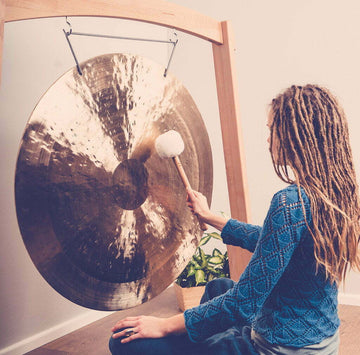
Note
Within the Peter Hess® Sound Methods, only Feng Gongs made from a high-quality bronze alloy are used to ensure a superior sound and vibration quality.
The method of production also plays an important role in the quality. A gong made from rolled bronze sheet does not produce a usable sound quality. Therefore, only gongs are used that are initially shaped from a thick bronze disc by machine hammering and then forged and hammered by hand.
The intensive forging process is essential because it strengthens the metal structure, resulting in the desired sound quality. The surface is then smoothed until it achieves its typical golden, shiny appearance, which gives this gong another name: the "Sun Gong." The craftsmanship and shape of this instrument allow for easy sound propagation, so it starts to vibrate powerfully when played with more force. This strongly moves the surrounding air, and the typical "fluttering" sound spreads out.
This type of gong is available in various sizes. Within the Peter Hess® Sound Methods, Feng Gongs with a diameter of 40–55 cm are primarily used.
The sound of the Feng Gong
- Powerful and intense
- Typical fluttery sound
What is a Bossed Gong?
The Bossed Gong, sometimes called the Thai Gong, is particularly widespread in Southeast Asia. It is available in various sizes and is characterized by a very distinct bulge in the middle. In contrast to the Flat Gong, it is only struck in the middle. Its sound is warm and calm and, compared to the TamTam Gong, does not swell after being struck, but develops a muffled and floating tone. In addition, the Bossed Gong has a specific pitch – this is explicitly not desired for a flat TamTam Gong.
What gong varieties are offered by Peter Hess®?
At Hess Sound, we offer Feng Gongs and TamTam Gongs in various designs, ensuring you quickly find the right instrument for you and your needs. All gongs we have distributed since 1989 come from our long-term partners and undergo several tests. Only selected instruments are sold. Due to high metal prices and their complex manufacturing processes, gongs are valuable instruments.
In Peter Hess® sound practice, these two types of gongs are primarily used. They must meet specific criteria that are essential for targeted use. Of course, you can also use our gongs for other purposes – be it for guided meditations, to accompany meditations, or as a musical instrument.
Note
If you're still unsure which gong is right for you, simply contact us and let our team advise you.

